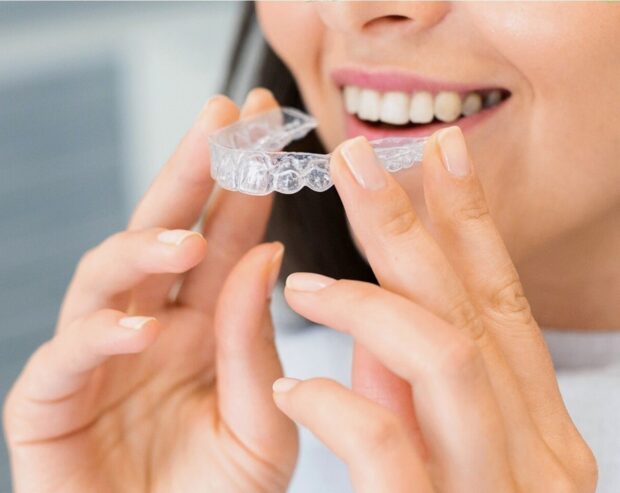Thinking about getting braces to straighten your teeth? Well, forget about the traditional metal braces, because there’s a new kid on the block: teeth aligners, with popular examples like Invisalign. But before you rush out to have your Invisalign initial consultation, you may want to learn more about why teeth aligners are a popular alternative to metal braces.
This article will look at the advantages of these aligners, their functionality, tips on selecting the perfect aligner for your needs, and of course, how they stack up against the tried-and-true traditional braces. So, read on to discover the wonders of teeth aligners.
The Benefits of Teeth Aligners
Teeth aligners offer several advantages over traditional braces. One of the main benefits is their discreet appearance. Unlike metal braces, aligners are made of clear plastic and are virtually invisible when worn, making them a popular choice for adults and teenagers who may feel self-conscious about wearing braces.
Another advantage of teeth aligners is that they are removable. This means you can take them out when eating, drinking or brushing your teeth. This makes maintaining good oral hygiene much easier compared to traditional braces, where food particles can get trapped and make cleaning more challenging.
Teeth aligners also tend to be more comfortable than traditional braces. The smooth plastic material used in aligners eliminates the risk of metal wires or brackets poking and irritating the inside of your mouth. What’s more, aligners are custom-made to fit your teeth, ensuring a snug and comfortable fit.
How Teeth Aligners Work
Teeth aligners are a modern solution to straightening your teeth. They work by applying gentle pressure to gradually move your teeth into the desired position. The process involves a series of aligners – each one slightly different from the previous one, to guide your teeth into alignment over time.
Your dentist or orthodontist will take impressions or digital scans of your teeth before starting the treatment. These impressions are used to create a 3D model of your teeth, which is then used to design a series of custom-made aligners.
Each aligner is worn for a specific period that is usually around two weeks, before moving on to the next one in the series. As you progress through the aligners, you will gradually see your teeth shifting into their new positions. The total duration of the treatment will depend on the complexity of your case and the specific aligner system used.
Choosing the Right Teeth Aligner for Your Need
When it comes to choosing the right teeth aligner, there are a few factors to consider. First, you’ll want to determine the severity of your misalignment. If you have minor alignment issues, clear aligners like Invisalign may be a suitable option. These aligners are virtually invisible and can be removed for eating and cleaning.
However, if you have more complex alignment issues, traditional braces may be a better choice. Braces use brackets and wires to gradually move your teeth into the desired position. While they may be more noticeable than clear aligners, they are often more effective for severe misalignments.
Another factor to consider is your lifestyle and personal preferences. Clear aligners are removable, which means you can continue to eat your favorite foods without restrictions. They also require less frequent visits to the orthodontist for adjustments. On the other hand, braces are fixed and require regular check-ups and adjustments.
It is essential to consult with a qualified dentist or orthodontist who can assess your specific needs and recommend the most appropriate treatment option for you.
Cost may also play a role in your decision. Clear aligners tend to be more expensive than traditional braces, but this can vary depending on your specific case and location. If you value aesthetics and the ability to remove your aligners when needed, then clear aligner systems may be the right choice for you. On the other hand, if you prefer a more cost-effective option, traditional braces may be a suitable option.
Comparing Teeth Aligners and Traditional Braces
As indicated earlier, teeth aligners and traditional braces are the two main options to consider when thinking of having your teeth straightened. Both methods have their own advantages and considerations. Traditional braces are generally more effective for complex orthodontic issues and can achieve more significant tooth movements. They are also less dependent on patient compliance since they are fixed in place.
On the other hand, teeth aligners offer a more discreet and comfortable option. They are removable, making it easier to maintain oral hygiene and enjoy your favorite foods without restrictions. However, aligners require a higher level of patient compliance since they need to be worn for at least 20-22 hours a day to be effective.
Ultimately, the choice between teeth aligners and traditional braces will depend on your specific needs, preferences and the recommendation of your dentist or orthodontist. It is important to consult with a dental professional to determine the most suitable option for achieving the desired results.










![Daily Bite [Make]: Philly Cheesesteak Stuffed Bell Peppers](https://dashofwellness.com/wp-content/uploads/2013/01/Philly-Cheesesteak-Stuffed-Pepper-Daily-Bite-1-100x70.png)
